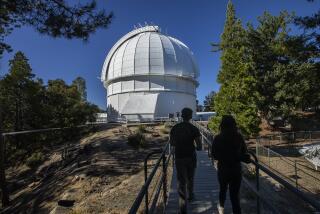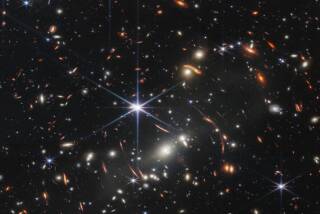Book review: George Johnson’s Miss Leavitt’s Stars
One of the most significant problems in astronomy is the measurement of distances to far-off celestial objects. A “distance ladder” is built up using increasingly sophisticated science. The first rung is straightforward: If you observe a distant object from two points along a baseline, it appears to shift as the background is observed from different angles. Measuring these angles and using trigonometry, you can find the object’s distance from the baseline in a method known as parallax.
The first star whose distance was found this way was 61 Cygni. The measurement was recorded in 1838 by the German astronomer Friedrich Wilhelm Bessel, who used Earth’s orbit around the sun as the baseline. The next rung on the ladder was an example of Louis Pasteur’s dictum of chance favoring the prepared mind. The chance I will come to shortly, but the prepared mind belonged to Henrietta Swan Leavitt, the subject of “Miss Leavitt’s Stars: The Untold Story of the Woman Who Discovered How to Measure the Universe,” a charming biography by New York Times science writer George Johnson.
Apart from her few and very important scientific papers, Leavitt left behind almost no traces of her life. She was born on the Fourth of July 1868 in Lancaster, Mass., and died of cancer on Dec. 12, 1921. Her will tells nearly all. She left an estate worth $314.91, mostly in Liberty Bonds, with a few items such as a desk valued at $5. She never married and had few living relatives. She also left behind a legacy of a great astronomical discovery.
Her family valued scholarship, so as a young woman she attended Oberlin College for two years and then enrolled at what would eventually be known as Radcliffe. Among the courses she took was one on astronomy that made occasional use of the “Great Refractor” telescope at Harvard. I took the same course more than half a century later and I think we used the same telescope.
During Leavitt’s time there, the observatory was under the direction of a young physicist named Edward Pickering. He hired a group of women called “computers” paid $10.50 a week to study photographic plates and to note aspects of what they saw. Leavitt began working there as a volunteer in 1893. She had independent means, meaning that Pickering did not have to pay her. She was assigned to study “variable stars,” whose luminosity varies over time. Variable stars had been of interest for years, but when she was studying those plates, I doubt Pickering thought she would make a significant discovery -- one that would eventually change astronomy.
Leavitt focused on Cepheid (variables) -- young stars, several times the mass of the sun, with about 10,000 times the luminosity. Because the ones closest to Earth are so bright, their variable luminosities can be studied. The luminosities go through a cycle, with each Cepheid having its own light curve. The ones Leavitt studied were in the Magellanic Clouds and all about the same distance from Earth, a fact that turned out to be crucial to her work. By 1908, she had studied 1,777 Cepheids. Of those, 16 lent themselves to detailed observation.
Leavitt made a remarkable discovery: These stars’ maximal brightness depended on the duration of the cycle. The maximum luminosity was proportional to a slowly varying function of the length of the cycle -- a logarithm.
If you measure a star’s luminosity at its surface, you are measuring its “intrinsic” luminosity. However, by the time you see the starlight on Earth it has become “diluted.” Indeed, it is not hard to convince yourself that the luminosity you see is diminished from the intrinsic luminosity by a factor of the square of the distance to the star.
Leavitt was “lucky.” All the Cepheids she studied were about the same distance from Earth, so the relationship she found did not have to be adjusted for these distances. However, because Cepheids are all over the place they can be used as “standard candles” for distance measurements.
To calibrate the actual distances to the Cepheids in, say, light-years, you need to measure the real distance to at least one by using another means, such as parallax. This was done in 1913 by Danish astronomer Ejnar Hertzsprung, who used the motion of the solar system as a base for his measurement.
Leavitt understood the implications of her discovery, namely that the real distances to distant astronomical objects were now measurable. It is a pity she did not live long enough to see its universal use.
In 1925, four years after Leavitt’s death, American astronomer Edwin Hubble published his seminal paper, “Cepheids in Spiral Nebulae.” He had used the 100-inch telescope at Mt. Wilson Observatory to study Cepheids in the Andromeda Nebula. Using their apparent luminosities, he found that Andromeda was outside the Milky Way and settled a dispute over whether the universe consisted of just our galaxy or whether it was one of many.
Though I enjoyed Johnson’s book greatly, it is not really the place to learn the science. He does not explain why the Cepheids have these variations in their luminosity. The point is that the layer near the surface of the star has a temperature of about 40,000 degrees. In that layer is helium, which has two negatively charged electrons circulating around its positively charged nucleus.
At these extreme temperatures, the electrons can get peeled off from the nucleus. When this happens, the radiation from the interior of the star interacts with the electrons and the layer becomes opaque. This layer, driven by the pressure of the trapped radiation, expands and cools, and the electrons recombine with the nuclei releasing the radiation and the cycle begins again. It’s similar to when the lid on a teapot pops up due to steam pressure, only to close again after the steam has been released. The more luminous the star, the longer it takes for the cycle to run its course. The devil is in the details.
I think if Leavitt were alive today to hear an explanation of “her” stars, she would be pleased -- and proud. I think she also would be very proud of Wendy Freedman, director of the Carnegie Observatories in Pasadena, one of the three principal investigators on the project that used the Hubble Space Telescope to study Cepheids at even greater distances and to provide the most accurate data available on the expansion rate of the universe. Unlike Miss Leavitt, she was allowed to study calculus and earn degrees and is paid properly for her work. *
More to Read
Sign up for our Book Club newsletter
Get the latest news, events and more from the Los Angeles Times Book Club, and help us get L.A. reading and talking.
You may occasionally receive promotional content from the Los Angeles Times.






